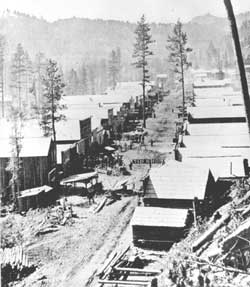|
|
Shootout on Railroad Avenue. |
|
Through the Swinbank and Armstrong accounts, we find that Quiet Joe has in fact made a family legend of himself. So much of his tale, set in the desert and mountains, living among the Souix and Apache, will have to remain a myth.

Joe at the Battle of Little Big Horn (1876)
An 1882 article from Albuquerque insinuates that Joe left Sam & Lou's company in Salt Lake City around 1873. The Armstrong account says that Joe first came to the Black Hills in 1874, as the rush to that area was just beginning. Custer's troops had recently discovered gold there, and were then still obstensibly trying to keep prospectors out.
Two stories place Joe Belonger in South Dakota in 1876. The first is the assertion in the Armstrong account that Joe tried to volunteer for Gen. George Custer's fateful attempt to roust the Sioux at the Little Big Horn. He would have been 29 at the time.
The detailed description of Joe's attempts, immediately after the battle, to get at the truth of the massacre make Joe sound more like an investigative journalist than the solitary miner that he was. Armstrong reveals that through dogged interrogation of children at the battle site, Joe determined that Custer had made an terrible blunder. While preparing to attack Sitting Bull and his war party of Sioux, Custer instead was overcome by an unexpected charge by the great Cheyenne chief Crazy Horse and his warriors, who quickly overcame Custer and his entire force.
We have not yet investigated what the common wisdom was in 1927, when Joe gave his testimony, or in 1962, when Mary Armstrong wrote the following:
A great deal of controversy has been going on all these years about which Indians killed Custer and his men. Some claim it was the Sioux under Sitting Bull; others declare that it was the Cheyennes. The truth is that not one white soldier escaped to tell the story; and both Sioux and Cheyennes were so frightened at what they had done that they all scattered and ran. The few who did talk told so many different stories that no white man could believe anything they said.
Joe, who kept his own counsel, told no one, except certain close relatives, the facts about Custer's death. This is the first public report. Today, as this piece is being typed in 1962, Gene Swinbank, of Shullsburg, Wisconsin, is the only person living who heard Joe Belonger tell how he learned the real truth about General Custer and the Little Big Horn tragedy.
The modern interpretation seems to be that it was a combined force of Sioux and Cheyenne fighters that overcame Custer's vastly undermanned cavalry.
The book Men With Custer, which lists every man, military and civilian, attached to Custer's Seventh Cavalry, does NOT mention Joe Belonger. This does not rule out the possibility of his presence, but inclusion would have strongly bolstered his case.

Joe and Wild Bill Hickok (1876)

The second incident comes from the brief Gene Swinbank account, which states that Joe Belonger was with Wild Bill Hickok in Deadwood, S.D., the night Hickok was murdered by Jack McCall, and that Joe "felt the wind of the bullet." Allowing for some poetic license on that account, it is entirely possible, and perhaps even provable, that Joe lived in Deadwood on August 2, 1876, the date of the famous incident. Deadwood was a mining town and Joe was a miner. It will be much harder to prove that he was in "the hall of Nuttall and Mann" when the murder occurred. Deadwood had only one newspaper, the Black Hills Pioneer, and not surprisingly, the articles that followed the incident do not mention the names of bystanders.
We can state with some confidence, however, that Lou was an acquaintance of Bill Nuttall, a sometime-grifter who spent time in Leadville in 1879 and Albuquerque in 1882, and was associated with several Blonger friends and rivals. Whether that has any significance we can't say at this time.
The Armstrong account, which is based on the same source (Gene Swinbank), mentions that Joe was a frequent card partner of Hickok.

Joe and Cochise, Geronimo, and Assorted Native American Friends
Joe claimed to have had the "friendship of all the Apaches, including Cochise and Mangus Colorado — and even the treacherous Geronimo, the most feared of all the Apaches." Up north in the Black Hills, he was a personal friend of both Sitting Bull and Crazy Horse. He recounts playing often with Indian children, teaching them to make whistles, and living peacefully in Apache villages of the Southwest, even at times when war parties might bring white scalps back to camp. He angrily decried the cruel acts and atrocities of "certain arrogant white soldiers," sounding a bit like Dances With Blonger.
We are also told Joe once saved a white settlement from Geronimo's braves. Having overheard the Apache plans, Joe finds Cochise and convinces him to trick Geronimo into delaying his attack, giving Joe time to warn the settlers.
Here we rely solely on the Virginia Armstrong account, and that may just be all she wrote. The account does, however, go into some detail describing Joe's relationship with Native Americans — more detail than any other subject. And as a prospector in the Black Hills or the deserts of the Southwest, Joe would have ample opportunity to interact with local peoples.

Joe and Buffalo Bill (1868-1880?)
In the Armstrong account, Joe claimed to have served many years as a part-time scout under Buffalo Bill. Possible. Cody's whereabouts are voluminously documented, so there may be proof. If we can trace Joe's movements we'll narrow the possibilities.
|



